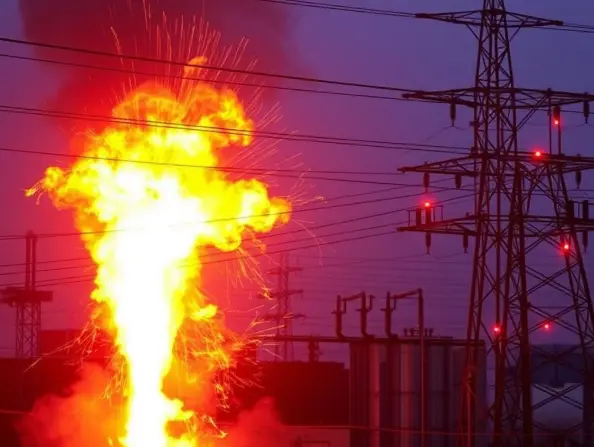
Load flow analysis is performed with the assistance of computer software like ETAP that simulates actual steady-state power grid operating conditions, by enabling the evaluation of bus voltage profiles, losses, real and reactive power flow.
Using multiple scenarios, load flow analysis helps the system to run with designed performance criteria.
Care Labs is a competent provider of Electrical Installation’s Study, Testing, Analysis, Inspection, and Certification services. It has been offering load flow and short circuit analysis in the fortune 500 companies across US for the past few years.
A load flow analysis is the study of steady state analysis in an electrical network that is handled by an engineer. The aim is to know the power flows around the electrical network.
Load flow analysis gives a balanced steady operation state for the power system, without considering system transient processes.
For radial systems, no formal load flow study is performed. For larger power distribution systems, it should carry a proper load flow study; typically using software like ETAP (Electrical Transient Analyzer Program)
Care Labs performs the load flow and short circuit analysis using ETAP software.
While performing a load flow analysis, it’s important to brief the electrical network and perform the calculations to get the required results.
The study of load flow involves the subsequent three steps:
- Modeling of power grid components and networks.
- Development of load flow equations.
- By solving the load flow equations using numerical methods or techniques.
In real-life load flow studies are carried out by using the software. The network nodes are interconnected by admittances, impedances.
Each system node has four key parameters:
- Active power (P)
- Reactive power (Q )
- Voltage magnitude (V)
- Voltage phase angle (δ)
By the nodes in a software model, the engineer typically considers three types:
- Load Bus [P-Q bus] – A bus where the real and reactive power is specified. The phase angle and voltage magnitude are calculated by the study.
- Generator Bus [P-V bus] – A bus in which the real power generation and voltage are known.
- Slack Bus (Swing bus) – The voltage magnitude and phase angle are assumed. The reactive and active power is calculated.
In several cases, the nodes are on load bus type. The nodes with a generator connected are of the generator bus type. In the case of more than one slack bus is defined, it is usual to have only one. This will consider as the connection point to the main grid supply.
Short Circuit Study & Analysis
Short circuit occurs when a part of a current carrying conductor touches or comes in contact with another wire or part of the circuit, current will flow along and cause a short circuit.
This will results in an excessive amount of current flow in the power systems through the path of low resistance.
This may cause for the damage of power source and it produces heat, fires etc. So it is mandatory to perform a short circuit study and analysis moreover use protection devices accordingly to counter short circuit currents in the power system.
The heat effect can damage the wiring insulation and electrical components.Short circuit analysis is used to find out the magnitude of the short circuit current.
The system can able to produce and compares that magnitude with the interrupting rating of the over current protective devices (OCPD). OCPD is a specific kind of current that produces a large amount of energy into a power system.
For a large system switchgear ratings and relay settings were performed to calculate the short circuit analysis.
Benefits of Short Circuit Analysis
Helps to avoid unplanned outages and downtime.
- Reduces the risk of device damage and fires
- Increases safety and protects people from injuries
- Helps to determine the level and type of protective devices that are needed.
- It gives the information needed for NEC and NFPA
- Keeps you compliance with NEC requirements.
Care Labs follows NFPA-70E, IEEE 1584 standards and guidelines to assure the highest industry standards.
NEC 110 requires a brief circuit analysis that finishes all electrical equipment and panels. The most adopted standards for circuit analysis are the ANSI/IEEE C37.010-1979 standard moreover the International Electrotechnical Commission (IEC) 60909 standard is also accepted.
We offer our services in California, New York, Illinois, Ohio, Texas, New Jersey, Pennsylvania, Georgia, Washington, Florida, Massachusetts, Michigan, North Carolina, New Mexico, Virginia, and all the major states and cities in the United States of America.
Contact us today to get load flow and short circuit analysis for your company.

The Importance of Relay Coordination in Power System
Introduction Relays are protective elements that help control faults in a power system. Proper relay coordination helps isolate the fault sections from healthier sections in a power system. Being a fundamental part of ensuring reliability and operational continuity, the strategic configuration of protective relays is imperative in the design of a power system. One way […]

Which of these Facts About Arc Flashes are True?
Introduction In electric hazards, arc flashes are among the most dreadful threats. Despite their criticality, many myths surround arc flashes. Although IEEE and NFPA continuously strive to enhance awareness, five to ten arc flashes happen in the USA daily. We, at Care Labs understand the importance of maintaining a healthy electrical infrastructure. To help companies […]

